The travel of the Stork—A “Loyal” Bird(The Original)
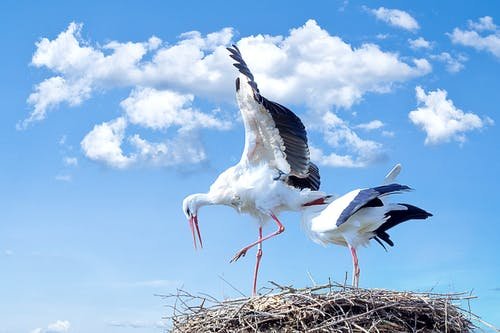
THE stork—traditional harbinger of spring, babies, and good fortune—has long held a special place in man’s myths and affections. Its graceful flight, its affinity for human settlements, and its useful role in controlling agricultural pests have all contributed to its popular image.
But perhaps its most endearing feature is its faithfulness—faithfulness to its nest, to which it returns every year, and loyalty to its mate, with which it forms a lifelong bond. In fact, its name in Hebrew means “loyal one” or “one of loving-kindness” because, as the Talmud explains, it is a creature distinguished for treating its mate with affection.
Thanks to this popular image, nearly two hundred years ago the stork was a protected species in Holland and, reportedly, tame storks could be seen strutting around the fish market of The Hague. It was later made the national bird of Germany. And nowadays, in many European towns, platforms are erected on roofs to encourage this friendly bird to nest on them. Storks are welcome neighbors!
Comings and Goings
Some European storks winter in West Africa south of the Sahara, while others travel as far as South Africa. They start the long journey south in August. As they are not strong fliers, the journey is done in stages. They prefer to migrate in groups of varying size, and often all the storks in a certain area will join up before departing on their migration. Being among the earliest migratory birds to return north, they arrive back at their nests in February or March.
Because of their size—they have a wingspan of about six feet [1.8 m]—and their dependability, migrating storks have always attracted attention. Large flocks punctually pass through Palestine in autumn and spring. More than 2,500 years ago, the prophet Jeremiah called attention to this fact, accurately describing the stork as a bird who “knows the time to migrate.”—Jeremiah 8:7, The New English Bible.
The distance they travel every year—a round-trip of over ten thousand miles [16,000 km] in some cases—is remarkable, all the more so considering that they glide most of the way. Like the large birds of prey, they rely on thermals, rising bodies of hot air, to gain altitude, after which they take advantage of their broad wings to glide effortlessly for long distances, only rarely beating their wings.
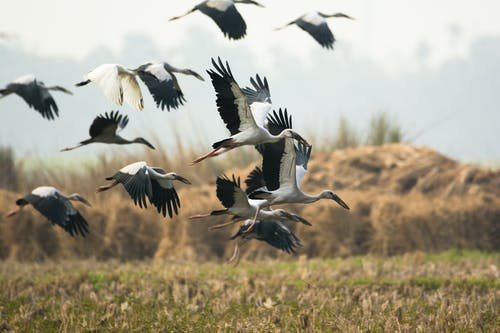
the stork bird in travel flight
A unique feature of the storks’ migration is their passage across the Mediterranean. They prefer not to travel over water, where thermals are absent. Thus, every August thousands of storks congregate to make the crossing at the two points where the distance over the water is the shortest (the Strait of Gibraltar and the Bosporus). Surprisingly, the long journey across the Sahara Desert does not daunt them as much as the nine-mile [14 km] stretch of water separating Spain and Africa, which can take them as much as five hours.
The Extraordinary Nest
Storks favor a nesting place in a prominent place, such as the top of a tall tree, although they will sometimes make do with a modern-day counterpart, an electrical pole. In Biblical times, they often built their “house” in juniper trees.—Psalm 104:17.
But for centuries, rooftops, churches, and chimneys throughout Europe have been favorite nesting sites. Both the male and the female bird patiently build the nest, an extraordinary structure that may well look as if it will topple off its perch at any moment. But appearances can be deceptive, and the large nests are rarely dislodged even during the most violent storms. So durable are the nests that the storks on returning each year usually just spend a week or so making minimal repairs to their home.
(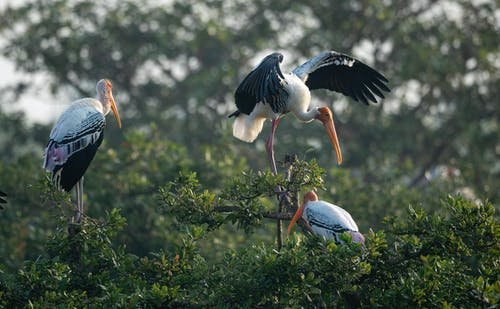
This repair work, which involves adding twigs and other material, is usually done by both storks as soon as they arrive from their winter quarters. And eventually, it is this repair work that brings about the nest’s demise—it just collapses under its own weight. By that time the nest may well be as much as seven feet [2 m] high and three or more feet [a meter or more] in diameter.
Just as the parents return to their nest every spring, so the offspring try to find a site as near as possible to their place of hatching. Thus, some old buildings become host to a dozen or more enormous nests, all occupied by descendants of one original pair.
The Current Plight of the Stork
Despite attempts to make the stork feel welcome in many European towns, its future looks bleak. Last century there were some 500 nests in Switzerland, but now only a handful remain. A similar gloomy picture emerges from Sweden, Holland, Denmark, and Germany, where their numbers are decreasing alarmingly. In Spain, where they are still a common sight, occupied nests have been reduced by half in just ten years. The whole European population is now estimated to be only from 10,000 to 20,000 pairs. What is happening to one of man’s favorite birds?
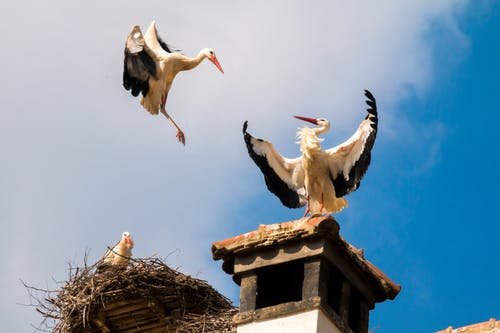
Apparently, many factors are involved, but most of them are related to man’s destruction of the environment. In their wintering grounds in Africa, storks are often hunted and killed for food: an ecological tragedy, as the storks spend the winter months gorging on the locust swarms that do so much damage to vital African crops. Meanwhile, in Europe infertile eggs, caused by widespread use of pesticides, and the loss of feeding grounds have resulted in fewer offspring being reared each year. Furthermore, power lines are a lethal hazard for many large birds, and trigger-happy hunters are responsible for the death of many others.
Conservationists are making efforts to protect the stork, but a successful program will depend on the cooperation of many nations, something that is not easy to achieve. Lovers of God’s creation trust that the time will never come when the majestic wings of the stork disappear from our skies, when spring is no longer heralded by this neighborly and loyal bird.
Storks and Babies
For centuries, children have been told that babies are brought by storks, and storks still feature prominently on cards congratulating parents on the birth of a baby. Where did the story originate?
Apparently, the idea is based on two legends. Years ago, people noticed that storks appeared seemingly miraculously each year at the same time. Some thought that they went to Egypt during the winter months and became men, only to revert to being birds in the spring (this explained their attachment to human dwellings).
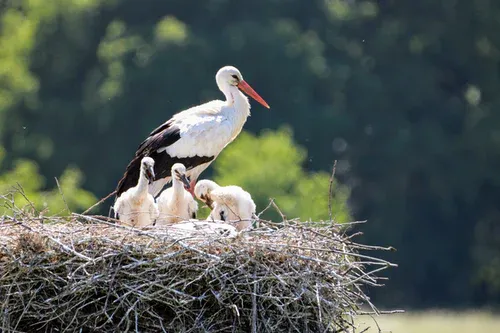
the stork bird on their nest with their babies
It was also noticed that storks spent most of the day feeding in marshy areas, which were said to be the dwelling place of the souls of newborn babies. As storks were birds that were most solicitous parents, it did not require too much imagination for people to link fact and fiction and come up with the notion that babies were brought by storks.
Credit for images:to pexel .com
You can read more of this powerful post from blog here:https://steemit.com/@agodaniel32/posts and can comment and upvote. Thanks very much for your time here. @OCD